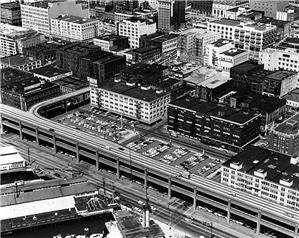On June 29, 1956, President Dwight D. Eisenhower (1890-1969) signs into law the National System of Interstate and Defense Highways Act. This Act provides 90 percent federal funding for a nationwide network of limited-access roads, and spurs the construction of the American Interstate Highway System. It funds construction of what is called the Seattle Freeway, the future Interstate 5.
The 60-year build-up to the 1956 federal funding of modern freeways began with public lobbying for good roads. At the end of the nineteenth century, 93 percent of the highways in this country were unimproved (plain dirt). Horse drawn vehicles and the railroad were the leading means of transportation. Autos came into use in the 1890s, and the first one arrived in Seattle in 1900. By the 1950s the Age of the Automobile had come into its own.
In the early 1900s, the American "Good Roads" movement held community workdays to improve local roads and lobbied Congress for official road planning oversight. Millionaire Washingtonian Sam Hill (1857-1931) was a prominent proponent of the Good Roads movement, and worked steadily to improve road conditions in the region. In 1905, Washington became the 14th state in the nation to establish a Highway Department.
Throughout the 1910s, 1920s and 1930s, federal road money was made available to states on a matching basis. The Federal Aid Road Act of 1916, Federal Highway Act of 1921, funds from the Depression-era Public Works Administration and Works Progress Administration targeted rural areas, the National Industrial Recovery Act targeted urban roads, and the 1944 Federal-Aid Highway Act proposed to link major cities in the interest of national defense. None of these efforts provided for more than 50 percent federal funding. Individual states would not or could not make up the difference, and road building lagged.
Some states tried to bridge the funding gap by building toll roads, but as the trucking industry battled the railroads for nationwide shipping dominance, truckers rebelled at increasing toll fees. President Eisenhower appointed Seattleite Dave Beck (1894-1993), who headed the Teamster's Union, to serve on a federal committee directed by General Lucius D. Clay (1897-1978). The Clay Committee was directed to mount a detailed study of specific nationwide highway needs. The committee endorsed heavy use of federal funds to finance interstate freeway construction and this was crucial to Congressional approval of Eisenhower's bill.
The National System of Interstate and Defense Highways passed both the House and the Senate on June 26, 1956, and on June 29 was signed into law. The state of Washington immediately sought funding approval for the Seattle Freeway (the future Interstate 5).

